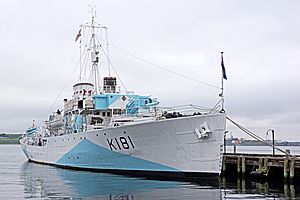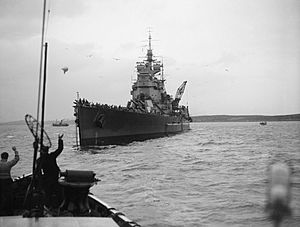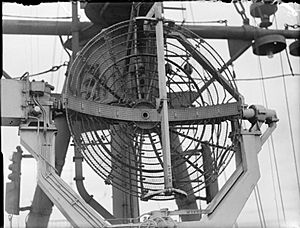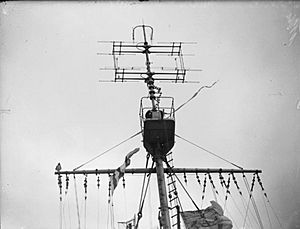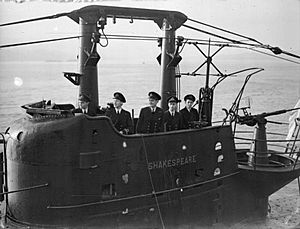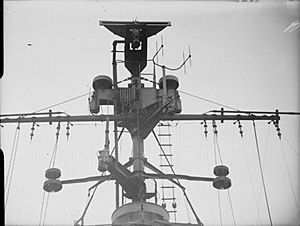List of World War II British naval radar facts for kids
Radar was a super important invention during World War II. It helped ships, planes, and armies find enemies even in the dark or bad weather. This page tells you about the different types of radar used by the British Royal Navy during the war. These radars were like the "eyes" of the ships, helping them spot enemy planes, ships, and even hidden U-boats (submarines) underwater.
How Radar Names Worked
At first, these radar sets were called "wireless telegraph" (w/t) sets. But soon, they added a special number "2" at the start to show they were radar.
Radars that used longer radio waves (called "metric" waves) had numbers like 280s and 290s. When newer, shorter wave radars (called "centimetric" waves) came along, they often got numbers by subtracting 10 from the metric version. For example, Type 284 became Type 274.
Sometimes, this wasn't possible because numbers like 271 to 274 were already used for the first centimetric radars. So, some metric sets had 20 subtracted instead (like Type 282 becoming Type 262).
Special letters were added to the end of the radar names to show changes:
- B meant the radar was changed to use just one antenna for sending and receiving signals.
- M, P, Q showed big changes or upgrades to the radar set.
- R meant a special panel was added to help measure distances more accurately.
- U meant it was changed to work best for ships near the coast.
- W meant it was made for use on submarines.
- X, Y, Z were for experimental versions that were still being tested.
ASV Mark II Radar
| Type | Peak Power (kW) | Frequency (MHz) | Wavelength (mm) | In Service |
|---|---|---|---|---|
| ASV Mark I/Mark II | 7 | 176 | 1700 | 1940 |
This was one of the first successful radars for planes to find ships or submarines. "ASV" stands for "Air to Surface Vessel." The ASV II was an improved version of ASV I. It helped Fleet Air Arm (FAA) planes, like the Fairey Swordfish, find and attack the huge German battleship Bismarck in May 1941.
ASV Mark III Radar
| Type | Peak Power (kW) | Frequency (MHz) | Wavelength (mm) | In Service |
|---|---|---|---|---|
| ASV III/XI | 50 | 3000 | 100 | 1943 |
This was the first successful airborne radar that used very short radio waves, called "microwave" radar. It was used on FAA planes like the Swordfish and Fairey Barracuda, and many RAF Coastal Command aircraft. This high-tech radar could spot even tiny things, like a submarine's periscope or snorkel. This made it super effective for hunting down submarines. The Mark XI was an even more advanced version just for the FAA.
Type 79 Radar
| Type | Peak Power (kW) | Frequency (MHz) | Wavelength (mm) | In Service |
|---|---|---|---|---|
| 79 | 70 | 42.8 | 7,000 | 1938 |
This was an early radar used for warning about incoming aircraft. It was first put on Sheffield, then Rodney, and later Curlew. About 40 of these sets were ordered.
Type 262 Radar
| Type | Peak Power (kW) | Frequency (MHz) | Wavelength (mm) | In Service |
|---|---|---|---|---|
| 262 | 30 | 9,670 | 31 |
This radar was used to help aim 40 mm Bofors anti-aircraft guns. It could lock onto a target and help the guns fire even if the crew couldn't see it. It had a special dish antenna that spun to scan the area.
Type 268 Radar
| Type | Peak Power (kW) | Frequency (MHz) | Wavelength (mm) | In Service |
|---|---|---|---|---|
| 268 | 40 | 9,386 | 32 |
This was the first naval radar that used "X band" radio waves. It was used on smaller ships to find targets and help with navigation.
Type 271 Radar
| Type | Peak Power (kW) | Frequency (MHz) | Wavelength (mm) | In Service |
|---|---|---|---|---|
| 271 | 5 | 2,997 | 100 | March 1941 |
| 271P | 90 | 2,997 | 100 | 1943 |
| 271Q | 90 | 2,997 | 100 | 1943 |
The Type 271 was a very important radar for finding targets on the sea. It was one of the first to use centimetric waves. It had separate antennas for sending and receiving signals, which were stacked up. These antennas were protected by a clear "lantern" shaped cover.
This radar was crucial because it allowed escort ships to reliably find surfaced U-boats or even just their periscopes. It was first used on HMS Orchis. Later versions, like the 271Q, were much more powerful. The Type 271 was widely used on smaller escort ships like corvettes and frigates.
Type 273 Radar
| Type | Peak Power (kW) | Frequency (MHz) | Wavelength (mm) | In Service |
|---|---|---|---|---|
| 273 | 90 | 2,997 | 100 | 1941 |
The Type 273 was a version of the 271, but it had much larger antennas (about 3 feet wide). These larger antennas helped it work even better. They were placed high up on the masts of bigger ships like cruisers and battleships.
In the famous Battle of the North Cape, HMS Duke of York used her Type 273 radar to find the German battleship Scharnhorst from a very long distance (45,000 yards or about 41 kilometers). This was even before the Scharnhorst could be seen! This radar was later replaced by the Type 276.
Type 274 Radar
| Type | Peak Power (kW) | Frequency (MHz) | Wavelength (mm) | In Service |
|---|---|---|---|---|
| 274 | 500 | 3,294 | 91 | 1944 |
This radar was a centimetric replacement for an older radar, Type 284. It was used on cruisers and battleships to help aim their main guns and see where their shots landed. It had "double cheese" antennas. A famous ship that used this radar was HMS Belfast.
Type 277 Radar
| Type | Peak Power (kW) | Frequency (MHz) | Wavelength (mm) | In Service |
|---|---|---|---|---|
| 277P | 400 | 2,997 | 100 | 1943 |
| 277Q | 500 | 2,997 | 100 | 1944 |
The Type 277 was a big improvement on the earlier Type 271. It used a single antenna for sending and receiving signals and a much more powerful "magnetron" (the part that creates the radar waves). This made it much better at finding targets. It was often used to find the height of targets in the sky.
Type 279 Radar
| Type | Peak Power (kW) | Frequency (MHz) | Wavelength (mm) | In Service |
|---|---|---|---|---|
| 279 | 70 | 39.9 | 7,450 | 1940 |
| 279M | 70 | 39.9 | 7,450 | 1941 |
This was an air warning radar that came after the Type 79. It had separate antennas for sending and receiving, but the Type 279M combined them into one. It could also help find targets on the surface and assist with aiming guns. It used a "Precision Ranging Panel" to send accurate distances directly to the gun aiming computers.
Type 281 Radar
| Type | Peak Power (kW) | Frequency (MHz) | Wavelength (mm) | In Service |
|---|---|---|---|---|
| 281 | 350 | 85 | 3,500 | 1940 |
The Type 281 was another important air warning radar. It also had separate antennas, but the Type 281B combined them. It was first put on HMS Dido and then HMS Prince of Wales. This radar could also help find targets on the surface and assist with aiming guns. It was very accurate at measuring distances, which helped the gun computers aim correctly.
Type 282 Radar
| Type | Peak Power (kW) | Frequency (MHz) | Wavelength (cm) | In Service |
|---|---|---|---|---|
| 282 | 25 | 600 | 50 | 1941 |
This radar helped aim the 40 mm Bofors guns and "multiple pom-pom" anti-aircraft guns. It used two special antennas called "Yagi antennas." Later versions, like Type 282M, had more power and better ways to aim.
Type 284 Radar
| Type | Peak Power (kW) | Frequency (MHz) | Wavelength (cm) | In Service |
|---|---|---|---|---|
| 284 | 25 | 600 | 50 | 1940 |
| 284M | 150 | 600 | 50 | 1941 |
| 284P | 150 | 600 | 50 | 1942 |
This radar was used on cruisers and battleships to measure distances for their main guns and to see where their shots landed. It used a technique called "lobe switching" to make its aiming more accurate. HMS Suffolk used this radar to track the German battleship Bismarck. The Type 284P was very important in the Battle of the North Cape, helping the Duke of York attack the Scharnhorst even when it couldn't be seen.
Type 285 Radar
| Type | Peak Power (kW) | Frequency (MHz) | Wavelength (cm) | In Service |
|---|---|---|---|---|
| 285 | 25 | 600 | 50 | 1941 |
| 285M | 150 | 600 | 50 | 1941 |
| 285P | 150 | 600 | 50 | 1942 |
This radar helped aim anti-aircraft guns. It was fitted to special gun directors. The Type 285M could give accurate distances and aiming information, but it wasn't great at finding height. The Type 285P was more accurate and used a "Precision Ranging Panel."
Type 291 Radar
| Type | Peak Power (kW) | Frequency (MHz) | Wavelength (mm) | In Service |
|---|---|---|---|---|
| 291 | 100 | 214 | 1,400 | 1941 |
These were air warning radars. The first Type 291 had an antenna that had to be aimed by hand. The Type 291M was better, with an antenna that could be moved by power and showed targets on a screen like a map. There were also special versions for coastal ships (U) and submarines (W).
Type 293 Radar
| Type | Peak Power (kW) | Frequency (MHz) | Wavelength (mm) | In Service |
|---|---|---|---|---|
| 293M | 500 | 2,997 | 100 | 1945 |
| 293P | 500 | 2,997 | 100 | 1945 |
| 293Q | 500 | 2,997 | 100 | 1945 |
The Type 293 used similar electronics to the Type 277, but it had a new antenna designed to look upwards. This helped it warn ships about planes flying above them, rather than just searching the surface. It had a "cheese" shaped antenna that got bigger in later versions (from 6 feet to 12 feet).
Precision Ranging Panel
The Precision Ranging Panel (PRP) was a special system that helped radar measure distances very, very accurately. It could also figure out how fast a target was moving. This information was then sent directly to the ship's gun aiming computers. It was first used in 1939 with the Type 280 radar and became common on many other radar types by 1941.
Mechanical Ranging Panel
Some radars, like the Type 282 and 285, used a simpler "mechanical ranging panel." This panel had a pointer that an operator moved over the radar screen to estimate the distance to a target. This distance was then sent to the gun aiming computers. Some versions could even keep track of the target's speed automatically.
See also


